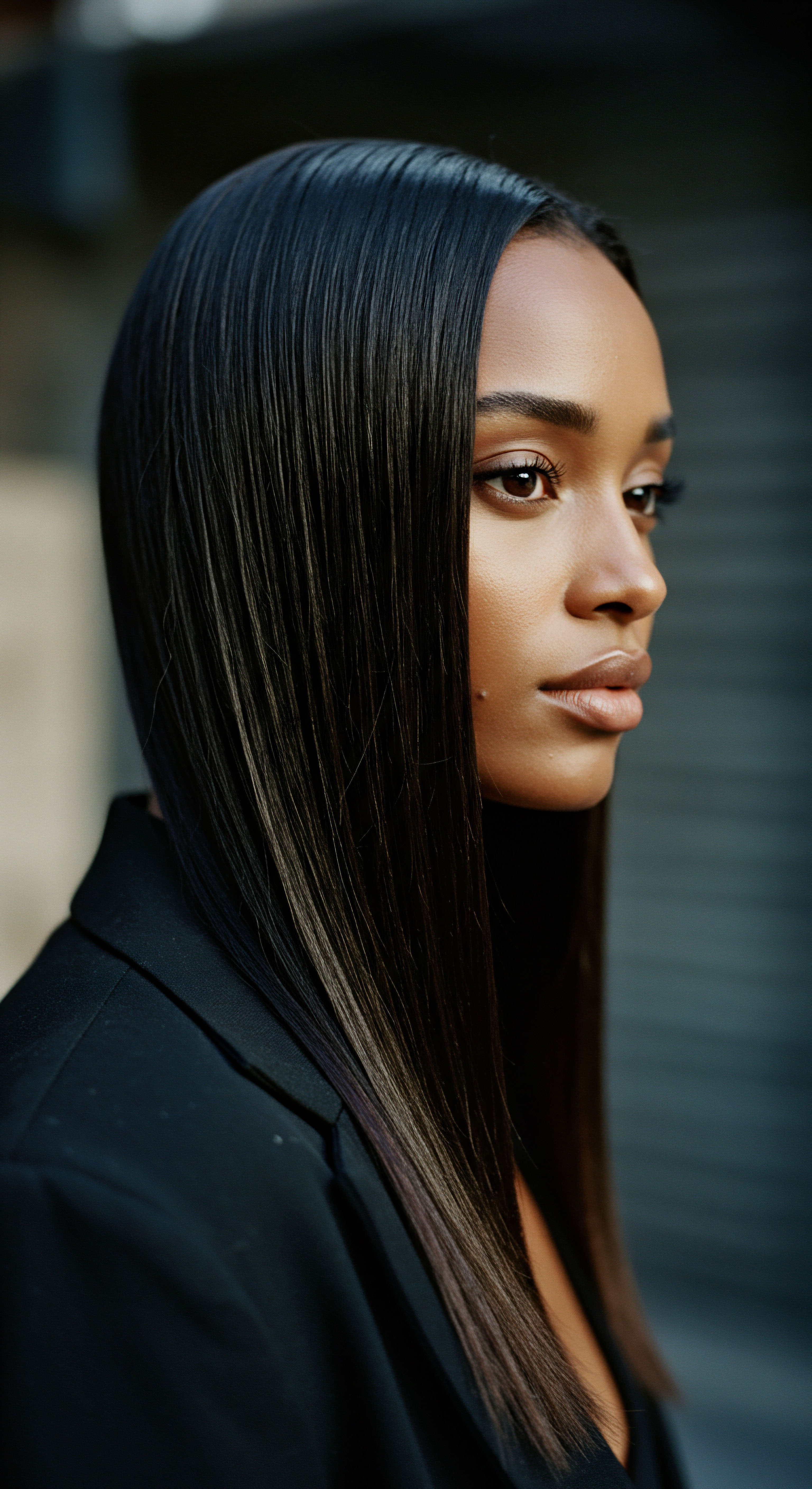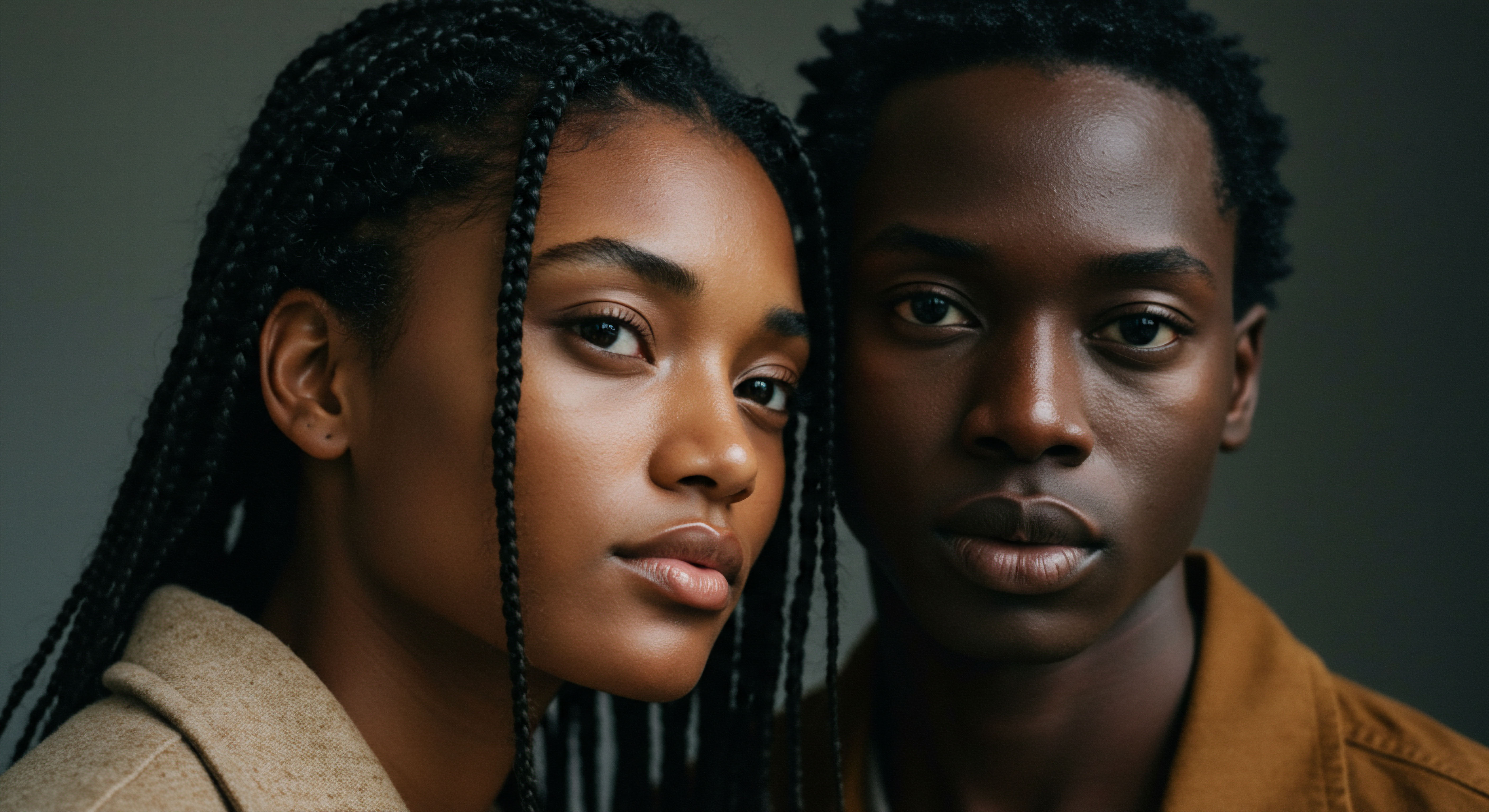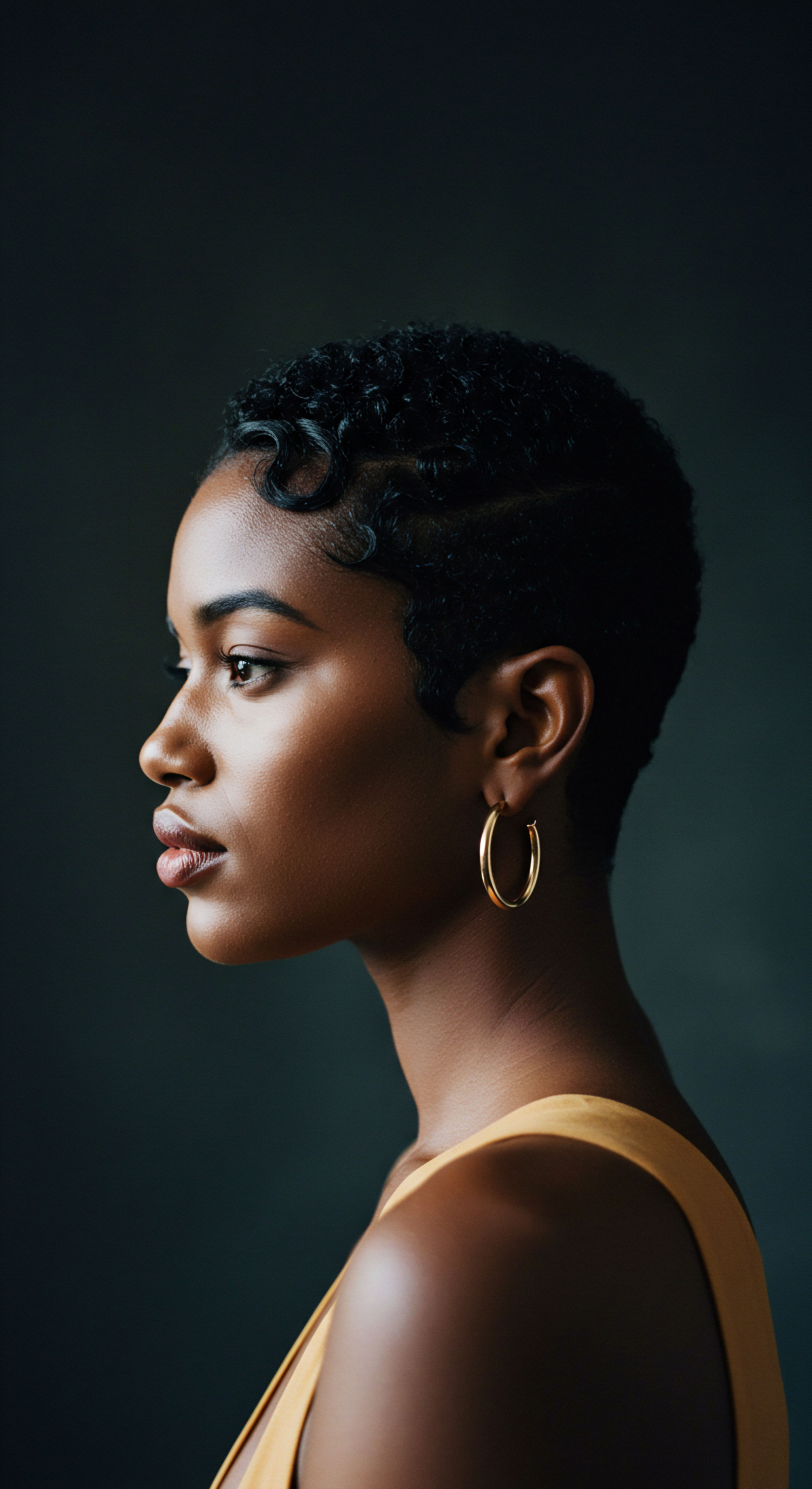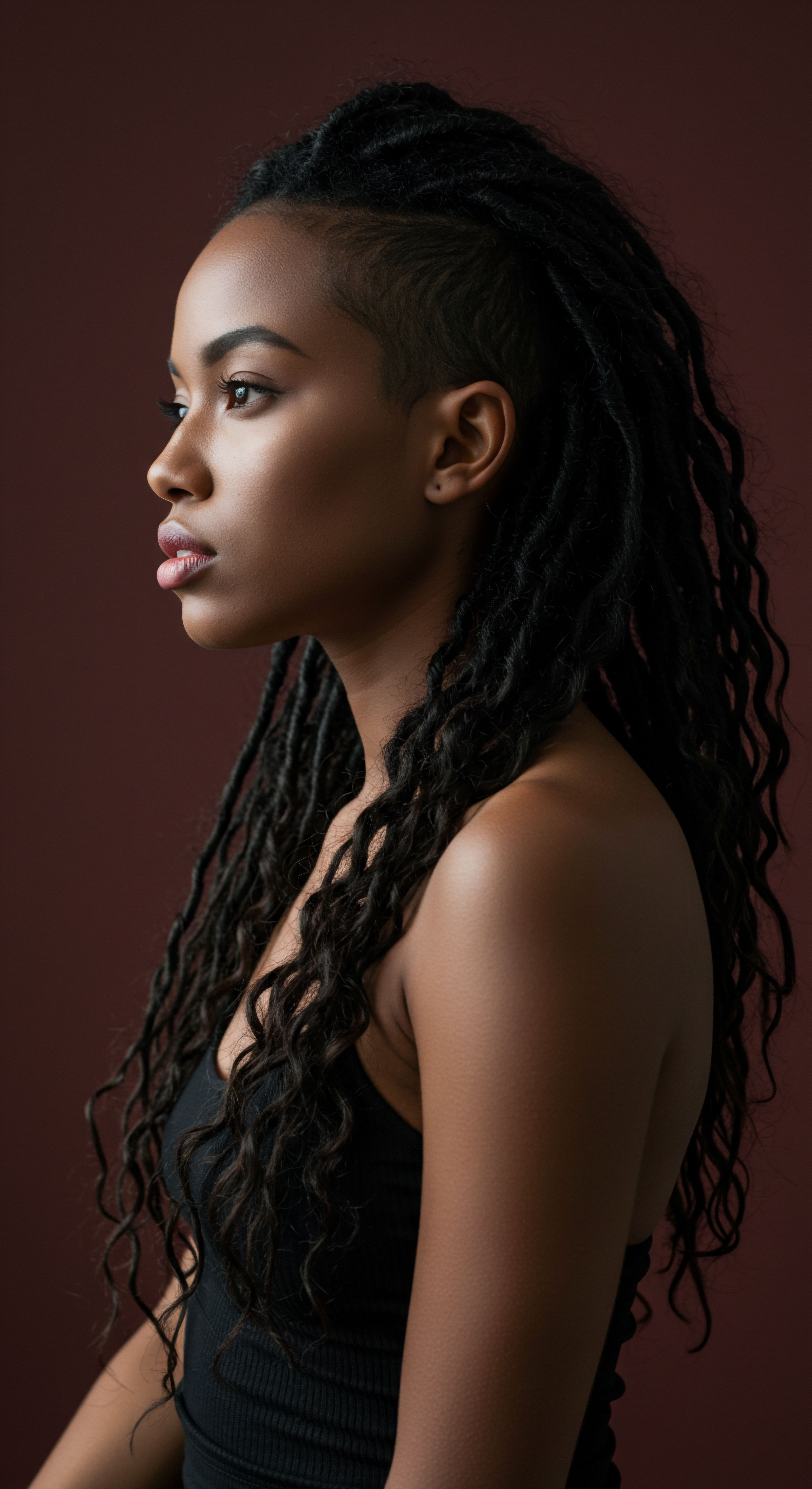
Roots
The story of hair is as old as humanity itself, a silent chronicle written in strands and adorned with meaning. It whispers of lineage, of spiritual connection, and of protection against the elements, speaking volumes without uttering a single sound. When we consider the profound relationship between ancient hair coverings and modern hair care, we begin to perceive a deeper understanding, far beyond simple aesthetics.
It invites us to pause, to look back through the ages, and to see how the very practices of our ancestors might offer gentle wisdom for our contemporary routines. This journey into historical customs reveals that the desire to safeguard and adorn our hair is not a passing trend, but a deeply ingrained human impulse.

A Crown of Meaning
Across diverse cultures and millennia, hair has served as a powerful visual marker. Ancient Egyptian depictions, for instance, showcase elaborate hairstyles, with wigs and braids signifying social status and religious beliefs. Archaeological finds from sites like Kerma in Sudan reveal intricate beadwork adorning hair, suggesting a long history of hair as a canvas for creative expression.
In many African societies, the specific wrapping style could indicate a person’s marital status, while in other communities, head coverings served as silent forms of resistance during times of oppression. The practice of adorning hair with amulets and charms was common, believed to guard against malevolent forces, linking hairstyles intricately to religious beliefs.
Hair, throughout history, has been a profound symbol of identity, status, and spiritual connection, its adornment often reflecting a deeper cultural narrative.
In Native American cultures, hair is a core tenet of identity. Many tribes consider hair sacred, believing it holds knowledge and wisdom, and that longer hair correlates with greater understanding. The act of cutting hair was often reserved for significant life changes or loss, and discarding cut hair was considered disrespectful, often ceremonially burned or buried. This deep reverence for hair as an extension of spirit, a physical connection to Mother Earth, underscores how hair was not merely a physical attribute but a living, breathing part of one’s being.

Early Protection Practices
Beyond symbolic significance, ancient hair coverings served very practical purposes. In arid climates, headwraps protected against harsh sun, dust, and wind. Egyptian hieroglyphs depict nobility wearing elaborate head coverings, hinting at their early social importance alongside their protective function.
In West Africa, archaeological evidence points to headwrap traditions dating back to the Kingdom of Ghana (300-1200 CE), with early wraps crafted from locally available textiles. These coverings were not just about appearance; they were essential tools for survival and health in challenging environments.
The earliest types of protective styles, particularly braids, have roots dating back to 3500 BC in African cultures. These styles were not solely for aesthetic appeal; they served as identifiers of family background, social status, spirituality, tribe, and marital status. The practical benefit of these styles lay in their ability to protect hair from environmental damage and reduce manipulation, a principle that echoes in modern protective styling.
- Headwraps shielded hair from environmental elements like sun, dust, and harsh winds, preventing dryness and damage.
- Braids, historically used in African cultures, reduced tangling and breakage by keeping hair contained and minimally manipulated.
- Natural Materials, such as plant fibers and animal hair, were incorporated into hairstyles for added length and protection.
| Region/Culture Ancient Egypt |
| Primary Significance Social status, religious beliefs, wealth |
| Practical Benefit Protection from elements, wig preservation |
| Region/Culture West Africa (e.g. Yoruba, Igbo) |
| Primary Significance Cultural identity, marital status, social standing |
| Practical Benefit Hair protection, reduced manipulation |
| Region/Culture Native American Tribes |
| Primary Significance Spiritual connection, wisdom, identity |
| Practical Benefit Hair preservation, ceremonial purpose |
| Region/Culture South Asia (e.g. India) |
| Primary Significance Modesty, cultural tradition, beauty |
| Practical Benefit Protection from dust, sun, pollution, reduced friction |
| Region/Culture Ancient hair coverings offered a dual purpose ❉ symbolic meaning and tangible hair protection. |

Ritual
As we move from the foundational understanding of hair’s place in ancient societies, a natural curiosity arises regarding the practical methods employed for its care. How did these historical understandings translate into daily practices, and what wisdom can we gather for our own hair journeys today? This section turns its attention to the routines, the intentional acts, and the gentle considerations that formed the core of hair wellness in times past, offering a bridge to contemporary routines. It invites a reflection on the conscious choices our ancestors made to preserve their hair, often with deep reverence.

Care Beyond Cosmetics
Hair care in ancient times was often deeply rooted in tradition and the resources available from the natural world. These practices were not merely about appearance but about maintaining the health and vitality of the hair and scalp. For Indian women, hair oiling represents a time-honored practice, following traditional Ayurvedic principles where natural oils infused with herbs are massaged into the hair.
This ritual is said to restore moisture, increase shine, and aid in growth, while also providing a relaxing, meditative experience. The passing down of these traditions from mothers to daughters highlights a communal aspect of care, where knowledge and stories were shared during the preparation and application of oils.
Ancient hair care was often a communal, mindful practice, emphasizing natural ingredients and protective measures.
Similarly, the Himba tribe women in Namibia apply a red pigment called otjize, a blend of animal fat, resin, and ochre, to their hair and skin. This practice beautifies and protects their hair from the harsh sun, especially important in regions with limited water. These examples underscore a holistic approach to hair care, where the environment, community, and available natural resources guided practices.

Can Ancient Covering Practices Directly Improve Modern Hair Health?
The core question of how ancient hair coverings might influence modern care finds a compelling answer in the principle of Protection. Many ancient coverings, such as headwraps and turbans, served to shield hair from external aggressors like sun, dust, and friction. This protective function is highly relevant today, particularly for textured hair, which is prone to dryness and mechanical damage. Modern scientific understanding validates the importance of reducing friction and maintaining moisture, directly aligning with these ancient practices.
For instance, the use of silk or satin bonnets in contemporary hair care directly mirrors the protective intent of many historical head coverings. Research confirms that silk bonnets reduce breakage by up to 43% compared to cotton alternatives over an 8-week testing period, while also helping to maintain moisture balance. This reduction in breakage stems from silk’s natural smoothness, which minimizes friction between hair strands and between hair and fabric. This suggests that the ancient intuition to cover hair for preservation has a clear scientific basis in modern trichology.
- Reduced Friction ❉ Head coverings, especially those made from smooth materials, minimized rubbing against rough surfaces like clothing or sleeping surfaces. This is a primary benefit echoed in modern silk or satin bonnets, which significantly reduce mechanical damage to the hair cuticle.
- Moisture Retention ❉ By covering hair, ancient peoples could help seal in natural oils and applied treatments, preventing rapid evaporation. Today, bonnets and scarves help textured hair, which is prone to moisture loss, retain hydration.
- Environmental Shielding ❉ Protection from sun, wind, and dust was a significant benefit of historical coverings. Modern care can learn from this by using coverings or styling to shield hair from harsh environmental conditions.
However, a nuanced perspective is necessary. While ancient coverings provided protection, certain practices, if not adapted, could potentially cause issues. For example, some religious head coverings, when worn too tightly or over wet hair, have been associated with conditions like traction alopecia or seborrheic dermatitis due to trapped moisture and reduced airflow.
A study comparing scalp microbiome in women wearing hijab to those not wearing hijab found differences, indicating that women wearing hijab might be more prone to seborrheic dermatitis, especially if practices like tight styling and infrequent washing of the covering occur. This highlights that the material, fit, and underlying hair practices are just as important as the act of covering itself.

Relay
Stepping deeper into the interconnectedness of hair, history, and health, we find ourselves contemplating not just the observable practices, but the underlying mechanisms and profound implications of ancient hair coverings. This segment seeks to illuminate the less apparent complexities, inviting a thoughtful consideration of how ancestral wisdom, when examined through a modern scientific and cultural lens, offers profound insights. It is a space where the whispers of the past meet the rigorous inquiries of the present, yielding a richer understanding of hair’s biological, psychological, and social dimensions.

The Biomechanics of Protection
The efficacy of ancient hair coverings in preserving hair health can be understood through the lens of biomechanics and material science. Textured hair, particularly curly and coily types, possesses a unique helical structure that makes it inherently more prone to mechanical damage and moisture loss compared to straight hair. The twists and turns along the hair shaft mean that the cuticle, the outermost protective layer, does not lie as flat. This lifted cuticle allows moisture to escape more readily and increases susceptibility to friction.
When ancient coverings, often made from smooth natural fibers like silk or finely processed cotton, enveloped the hair, they created a micro-environment that mitigated these vulnerabilities. This smooth interface significantly reduced the friction that hair would otherwise experience against rough surfaces, such as coarse sleeping mats, rough clothing, or abrasive environmental elements. The reduction in friction directly translates to less cuticle lifting, fewer snags, and a lower incidence of breakage. This principle is a cornerstone of modern textured hair care, advocating for silk or satin pillowcases and bonnets.
A study published in the Journal of Cosmetic Science noted that high porosity hair, often characteristic of textured hair, is more susceptible to mechanical damage. By reducing friction, ancient coverings inadvertently addressed this susceptibility.

Do Traditional Covering Materials Offer Superior Protection Compared to Modern Synthetics?
The choice of material for ancient hair coverings was often dictated by local availability, yet many traditional materials, like silk, possessed inherent properties beneficial for hair. Silk, a natural protein fiber, contains amino acids that are remarkably compatible with human hair. Its smooth surface exhibits a low friction coefficient, typically between 0.7-1.2 micrometers, significantly lower than cotton’s 4-5 micrometers. This scientific observation provides a compelling explanation for the efficacy of silk in modern bonnets, where clinical testing demonstrates a 43% reduction in hair breakage compared to cotton.
While modern synthetics can mimic some properties of natural fibers, their breathability and interaction with the scalp microbiome warrant careful consideration. For instance, tightly worn synthetic head coverings, especially if not regularly cleaned or if worn over wet hair, can create a warm, humid environment. This can alter the scalp’s delicate microbial balance, potentially leading to issues such as increased fungal growth (e.g. Malassezia restricta) and contributing to conditions like seborrheic dermatitis.
| Material Silk |
| Friction Coefficient (Approx.) 0.7-1.2 µm |
| Moisture Absorption Low (absorbs ~11% weight) |
| Impact on Hair Reduces breakage, retains moisture |
| Material Cotton |
| Friction Coefficient (Approx.) 4-5 µm |
| Moisture Absorption High (absorbs ~25% weight) |
| Impact on Hair Increases friction, can dry hair |
| Material Some Synthetics |
| Friction Coefficient (Approx.) Variable, can be higher |
| Moisture Absorption Variable, can trap moisture |
| Impact on Hair Potential for static, reduced breathability, scalp issues |
| Material The smooth, low-absorption qualities of natural silk align with optimal hair protection principles. |

Cultural Resilience and Hair Identity
Beyond the physical aspects, ancient hair coverings hold deep psychological and social significance that resonates today. Hair has long been a canvas for self-expression and a mirror reflecting personality and identity. In many cultures, hairstyles and coverings signified rites of passage, marital status, or community values. For Black communities worldwide, hair, and its covering, has been a symbol of pride, resilience, and heritage.
A powerful historical example comes from the Tignon Laws enacted in Louisiana in the late 18th century. Free Black women were compelled to wear headwraps (tignons) in public, ostensibly to signify their social status. Yet, these women transformed an instrument of oppression into a statement of dignity and fashion, using luxurious fabrics and elaborate styles to assert their identity.
This act of defiance, transforming a symbol of subjugation into one of beauty and cultural pride, offers a profound lesson in resilience and self-definition through hair adornment. The CROWN Act in California, which made it illegal to discriminate based on natural hair, echoes this historical struggle for hair autonomy and recognition.
The historical act of covering hair, often born of necessity or oppression, evolved into a powerful statement of cultural pride and self-determination.
This historical context informs the contemporary resurgence of headwraps and bonnets, not just as protective tools, but as statements of cultural belonging and self-acceptance. Wearing a headwrap today can be an act of honoring roots, appreciating cultural artistry, or simply expressing a connection to heritage. It underscores that hair care extends beyond scientific principles; it encompasses the psychological comfort and cultural affirmation derived from practices passed down through generations. The choice to cover one’s hair, whether for religious observance, practical protection, or cultural expression, becomes a conscious act of self-care and identity affirmation.
- Cultural Continuity ❉ Modern use of headwraps and bonnets connects individuals to ancestral practices and heritage.
- Identity Affirmation ❉ These coverings serve as a visual declaration of cultural pride and self-acceptance, particularly for textured hair.
- Psychological Well-Being ❉ The feeling of protection and connection to history can contribute to a sense of serenity and confidence in one’s hair journey.

Reflection
The quiet wisdom of ancient hair coverings, once perceived as relics of a distant past, now whispers insights into our modern care routines. It suggests that the desire to protect and adorn our hair, deeply rooted in human experience, carries profound lessons for contemporary textured hair wellness. We see how simple acts of covering, born of necessity or cultural expression, offered a foundation for maintaining hair integrity, a principle validated by today’s scientific understanding of friction and moisture.
This ongoing conversation between ancient practices and modern science invites us to approach our hair with a blend of reverence for its heritage and curiosity for its biological needs. It reminds us that true care extends beyond products, touching upon identity, protection, and the timeless pursuit of healthy, vibrant strands.

References
- Byrd, A. & Tharps, L. L. (2001). Hair Story ❉ Untangling the Roots of Black Hair in America. St. Martin’s Press.
- Dabiri, E. (2020). Twisted ❉ The Tangled History of Black Hair Culture. Harper Perennial.
- Davis-Sivasothy, A. (2011). The Science of Black Hair ❉ A Comprehensive Guide to Textured Hair Care. Sivasothy Publishing.
- Ellington, T. (2020). Textures ❉ The History and Art of Black Hair. Schiffer Publishing.
- Douglas, M. (1966). Purity and Danger ❉ An Analysis of Concepts of Pollution and Taboo. Routledge.
- Frazer, J. G. (1922). The Golden Bough ❉ A Study in Magic and Religion. Macmillan.
- Al Badi, S. & Khan, S. A. (2012). Formulation and Evaluation of Herbal Shampoo. Journal of Pharmacognosy and Phytochemistry, 1(4), 11-14.
- Shareef, A. et al. (2023). Religious headwear and alopecia ❉ considerations for dermatologists. Journal of the American Academy of Dermatology, 89(3), 633-636.
- Indrasari, D. L. et al. (2020). Scalp microbiome of healthy women wearing hijab compared to those not wearing hijab ❉ A cross-sectional study. Journal of Cosmetic Dermatology, 19(12), 3290-3296.
- Rele, J. S. & Mohile, R. B. (2003). Effect of mineral oil, sunflower oil, and coconut oil on prevention of hair damage. Journal of Cosmetic Science, 54(2), 175-192.
- Gavazzoni Dias, M. F. (2015). Hair cosmetics ❉ An overview. International Journal of Trichology, 7(1), 2-15.
- Robbins, C. R. (2012). Chemical and Physical Behavior of Human Hair (5th ed.). Springer.
- NYSCC. (2020). An Overview on Hair Porosity. New York Society of Cosmetic Chemists.